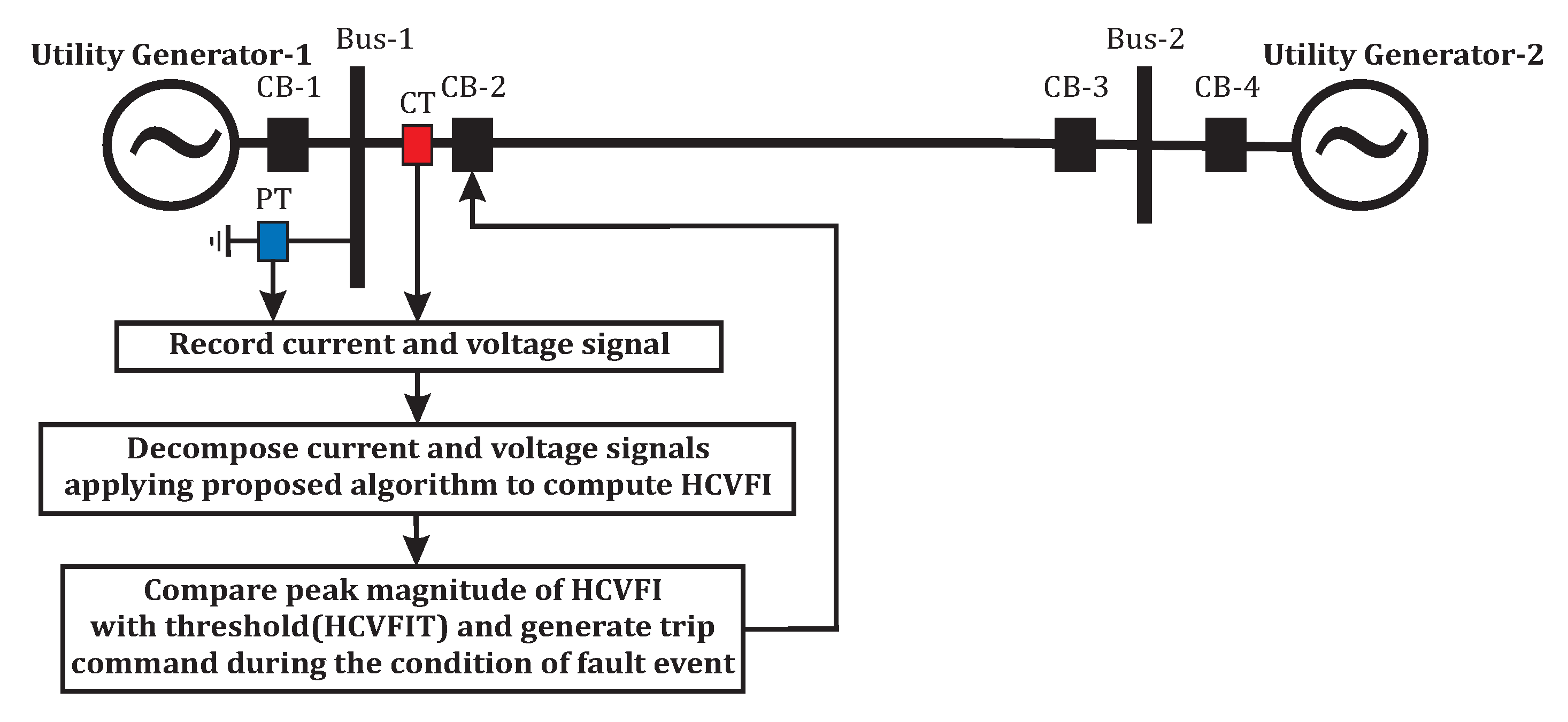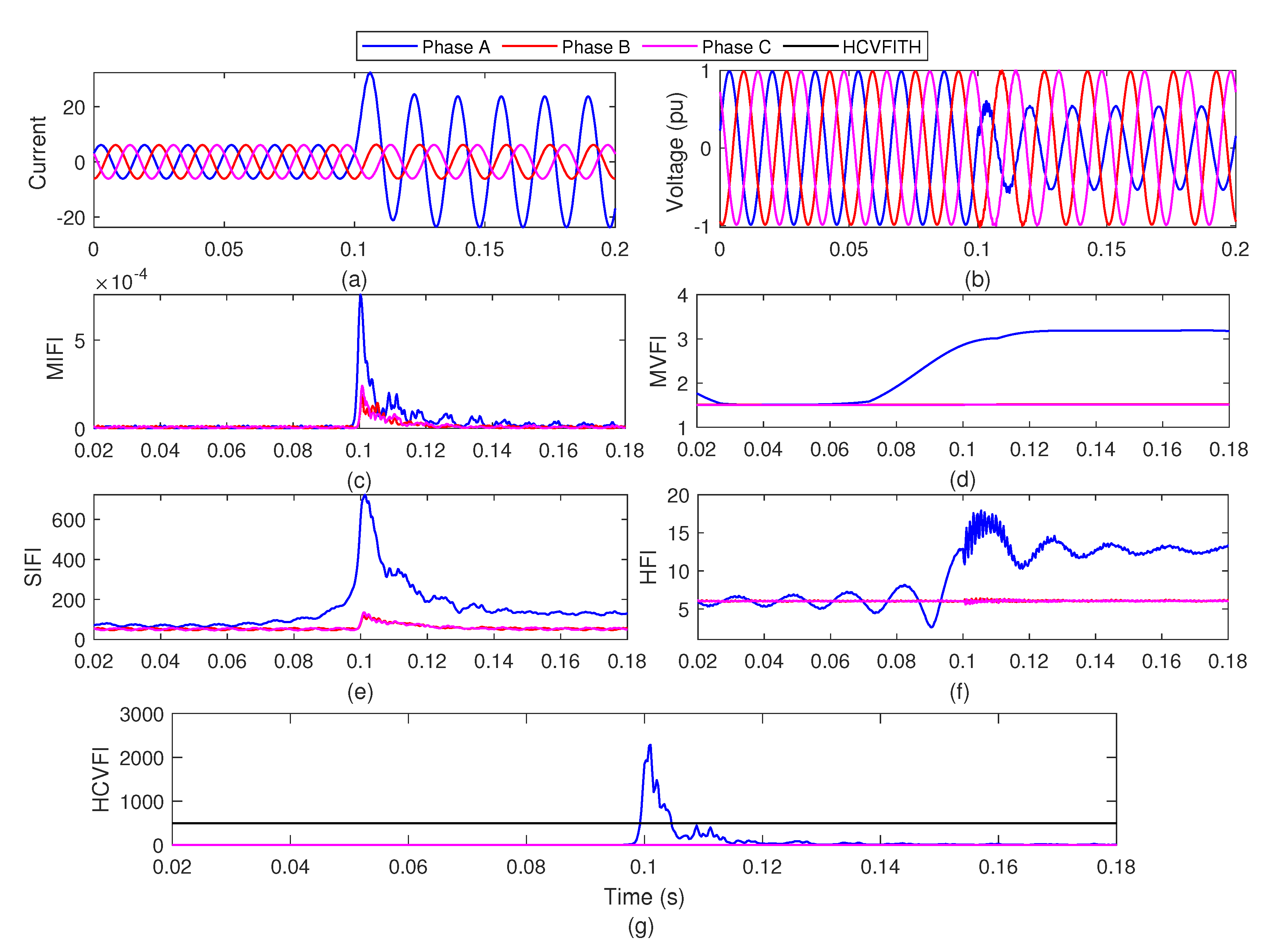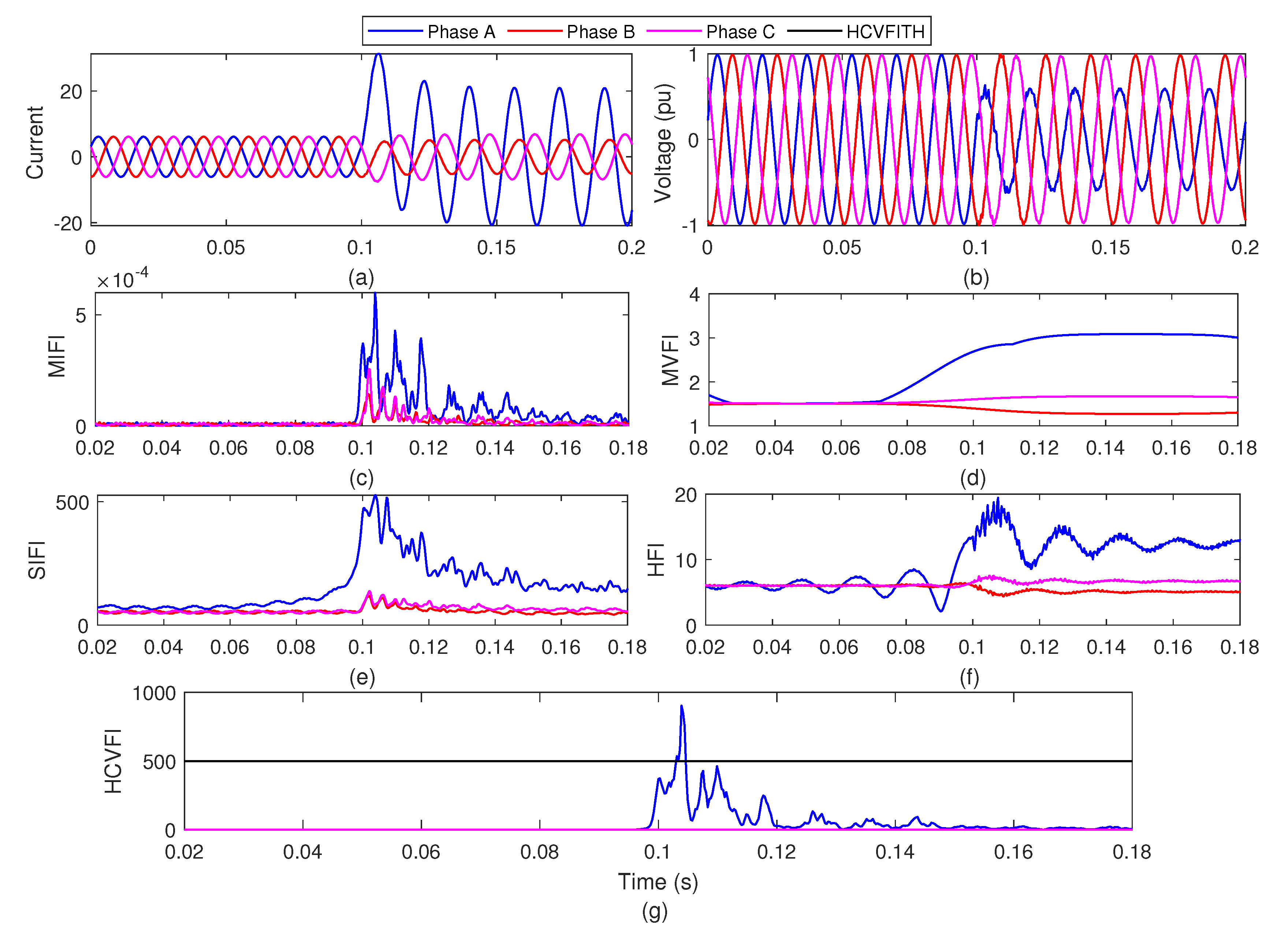Figure 1.
Test power line and installation of protection scheme [
11].
Figure 1.
Test power line and installation of protection scheme [
11].
Figure 2.
Fault estimation and categorization algorithm [
11].
Figure 2.
Fault estimation and categorization algorithm [
11].
Figure 3.
Estimation of AG faults using the current- and voltage-actuated protection method. (a) Currents of all phases, (b) voltages of all phases, (c) MIFI, (d) MVFI, (e) SIFI, (f) HFI, and (g) HCVFI.
Figure 3.
Estimation of AG faults using the current- and voltage-actuated protection method. (a) Currents of all phases, (b) voltages of all phases, (c) MIFI, (d) MVFI, (e) SIFI, (f) HFI, and (g) HCVFI.
Figure 4.
Estimation of AB faults using the current- and voltage-actuated protection method. (a) Currents of all phases, (b) voltages of all phases, (c) MIFI, (d) MVFI, (e) SIFI, (f) HFI, and (g) HCVFI.
Figure 4.
Estimation of AB faults using the current- and voltage-actuated protection method. (a) Currents of all phases, (b) voltages of all phases, (c) MIFI, (d) MVFI, (e) SIFI, (f) HFI, and (g) HCVFI.
Figure 5.
Estimation of ABG faults using the current- and voltage-actuated protection method. (a) Currents of all phases, (b) voltages of all phases, (c) MIFI, (d) MVFI, (e) SIFI, (f) HFI, and (g) HCVFI.
Figure 5.
Estimation of ABG faults using the current- and voltage-actuated protection method. (a) Currents of all phases, (b) voltages of all phases, (c) MIFI, (d) MVFI, (e) SIFI, (f) HFI, and (g) HCVFI.
Figure 6.
Estimation of ABC faults using the current- and voltage-actuated protection method. (a) Currents of all phases, (b) voltages of all phases, (c) MIFI, (d) MVFI, (e) SIFI, (f) HFI, and (g) HCVFI.
Figure 6.
Estimation of ABC faults using the current- and voltage-actuated protection method. (a) Currents of all phases, (b) voltages of all phases, (c) MIFI, (d) MVFI, (e) SIFI, (f) HFI, and (g) HCVFI.
Figure 7.
Estimation of ABCG faults using the current- and voltage-actuated protection method. (a) Currents of all phases, (b) voltages of all phases, (c) MIFI, (d) MVFI, (e) SIFI, (f) HFI, and (g) HCVFI.
Figure 7.
Estimation of ABCG faults using the current- and voltage-actuated protection method. (a) Currents of all phases, (b) voltages of all phases, (c) MIFI, (d) MVFI, (e) SIFI, (f) HFI, and (g) HCVFI.
Figure 8.
Index for ground detection.
Figure 8.
Index for ground detection.
Figure 9.
Estimation of AG faults with a fault angle of 45 using the current- and voltage-actuated protection method. (a) Currents of all phases, (b) voltages of all phases, (c) MIFI, (d) MVFI, (e) SIFI, (f) HFI, and (g) HCVFI.
Figure 9.
Estimation of AG faults with a fault angle of 45 using the current- and voltage-actuated protection method. (a) Currents of all phases, (b) voltages of all phases, (c) MIFI, (d) MVFI, (e) SIFI, (f) HFI, and (g) HCVFI.
Figure 10.
Estimation of AG faults with a fault incidence angle of 90° using the current- and voltage-actuated protection method. (a) Currents of all phases, (b) voltages of all phases, (c) MIFI, (d) MVFI, (e) SIFI, (f) HFI, and (g) HCVFI.
Figure 10.
Estimation of AG faults with a fault incidence angle of 90° using the current- and voltage-actuated protection method. (a) Currents of all phases, (b) voltages of all phases, (c) MIFI, (d) MVFI, (e) SIFI, (f) HFI, and (g) HCVFI.
Figure 11.
Estimation of AG faults with a fault impedance of 5 using the current- and voltage-actuated protection method. (a) Currents of all phases, (b) voltages of all phases, (c) MIFI, (d) MVFI, (e) SIFI, (f) HFI, and (g) HCVFI.
Figure 11.
Estimation of AG faults with a fault impedance of 5 using the current- and voltage-actuated protection method. (a) Currents of all phases, (b) voltages of all phases, (c) MIFI, (d) MVFI, (e) SIFI, (f) HFI, and (g) HCVFI.
Figure 12.
Estimation of AG fault incidents at a location of 30 km from the sending terminal of the transmission line using the current- and voltage-actuated protection method. (a) Currents of all phases, (b) voltages of all phases, (c) MIFI, (d) MVFI, (e) SIFI, (f) HFI, and (g) HCVFI.
Figure 12.
Estimation of AG fault incidents at a location of 30 km from the sending terminal of the transmission line using the current- and voltage-actuated protection method. (a) Currents of all phases, (b) voltages of all phases, (c) MIFI, (d) MVFI, (e) SIFI, (f) HFI, and (g) HCVFI.
Figure 13.
Estimation of AG fault incidents at a location of 120 km from the sending terminal of the power line using the current- and voltage-actuated protection method. (a) Currents of all phases, (b) voltages of all phases, (c) MIFI, (d) MVFI, (e) SIFI, (f) HFI, and (g) HCVFI.
Figure 13.
Estimation of AG fault incidents at a location of 120 km from the sending terminal of the power line using the current- and voltage-actuated protection method. (a) Currents of all phases, (b) voltages of all phases, (c) MIFI, (d) MVFI, (e) SIFI, (f) HFI, and (g) HCVFI.
Figure 14.
The 400kV S/C Jodhpur–Kankroli practical transmission line of the Indian Grid.
Figure 14.
The 400kV S/C Jodhpur–Kankroli practical transmission line of the Indian Grid.
Figure 15.
HCVFI for an AG fault incident on a practical transmission line.
Figure 15.
HCVFI for an AG fault incident on a practical transmission line.
Table 1.
Magnitude of HCVFI during faulty conditions.
Table 1.
Magnitude of HCVFI during faulty conditions.
| S. No. | Parameter | Magnitude of Parameter |
|---|
| 1 | Line length | 150 km |
| 2 | UG-1 voltage | 500 ∠ 20 kV |
| 3 | UG-2 voltage | 500 ∠ 0 kV |
| 4 | UG-1 equivalent impedance | 17.177 + j45.529 |
| 5 | UG-2 equivalent impedance | 15.31 + j45.925 |
| 6 | Line positive sequence impedance | 4.983 + j117.83 |
| 7 | Line zero sequence impedance | 12.682 + j364.196 |
| 8 | Line positive sequence admittance | j1.468 m℧ |
| 9 | Zero sequence admittance of transmission line | j1.099 m℧ |
| 10 | Line power transfer capacity | 433.63 + j294.52 MVA |
Table 2.
Magnitudes of HCVFI for investigated faults.
Table 2.
Magnitudes of HCVFI for investigated faults.
| Fault Name | HCVFI |
|---|
| Phase-A | Phase-B | Phase-C |
|---|
| AG | 1.1596 × | 2.9253 × 10 | 6.1953 × 10 |
| AB | 3.4410 × 10 | 7.6077 × | 1.9314 × |
| ABG | 6.7301 × 10 | 4.8628 × 10 | 1.3624 × 10 |
| ABC | 4.9292 × 10 | 3.7025 × 10 | 3.1787 × 10 |
| ABCG | 4.9292 × 10 | 3.7025 × 10 | 3.1787 × 10 |
Table 3.
Magnitudes of HCVFI for AG faults with different fault incidence angles.
Table 3.
Magnitudes of HCVFI for AG faults with different fault incidence angles.
| Fault Incidence Angle | HCVFI |
|---|
| Phase-A | Phase-B | Phase-C |
|---|
| 1.1596 × 10 | 2.9253 × 10 | 6.1953 × 10 |
| 1.5729 × 10 | 1.6947 × 10 | 1.9282 × 10 |
| 2.6444 × 10 | 2.1137 × 10 | 2.5749 × 10 |
| 2.9118 × 10 | 1.7011 × 10 | 1.2399 × 10 |
| 2.7605 × 10 | 2.4511 × 10 | 5.4373 × 10 |
| 1.8069 × 10 | 2.3092 × 10 | 4.0983 × 10 |
| 1.4967 × 10 | 3.2953 × 10 | 5.0839 × 10 |
Table 4.
Magnitudes of HCVFI for AG faults with different fault impedances.
Table 4.
Magnitudes of HCVFI for AG faults with different fault impedances.
| Fault Impedance | HCVFI |
|---|
| Phase-A | Phase-B | Phase-C |
|---|
| 1.1596 × 10 | 2.9253 × 10 | 6.1953 × 10 |
| 7.0187 × 10 | 2.9450 × 10 | 5.1641 × 10 |
| 4.0913 × 10 | 2.8969 × 10 | 4.2383 × 10 |
| 2.9786 × 10 | 2.8140 × 10 | 3.4607 × 10 |
| 4.0558 × 10 | 2.7107 × 10 | 2.8331 × 10 |
| 5.4548 × 10 | 2.5949 × 10 | 2.3555× 10 |
| 6.3866 × 10 | 7.3598 × 10 | 1.9503 × 10 |
Table 5.
Magnitudes of HCVFI for AG faults at different fault locations.
Table 5.
Magnitudes of HCVFI for AG faults at different fault locations.
| Fault Location | HCVFI |
|---|
| Phase-A | Phase-B | Phase-C |
|---|
| 20 km | 8.1529 × 10 | 0.0098 | 0.0191 |
| 40 km | 8.0364 × 10 | 3.6033 × 10 | 0.0011 |
| 60 km | 1.7889 × 10 | 3.6384 × 10 | 1.7873 × 10 |
| 80 km | 1.1774 × 10 | 9.2254 × 10 | 6.3385 × 10 |
| 100 km | 7.3322 × 10 | 9.2265 × 10 | 7.0646 × 10 |
| 120 km | 5.1786 × 10 | 3.0758 × 10 | 0.0056 |
| 140 km | 4.6031 × 10 | 0.0048 | 0.2228 |
Table 6.
Number of extra-high voltage grid sub-stations.
Table 6.
Number of extra-high voltage grid sub-stations.
| Sr. No. | Voltage Level of GSS | Total Number of Existing GSS | Total Number of under Construction GSS |
|---|
| 1 | 765 kV | 2 | 2 |
| 2 | 400 kV | 18 | 6 |
| 3 | 220 kV | 128 | 22 |
| 4 | 132 kV | 469 | 44 |
| Total | - | 617 | 74 |
Table 7.
Circuit length of extra-high voltage transmission lines.
Table 7.
Circuit length of extra-high voltage transmission lines.
| Sr. No. | Voltage Level of GSS | Length of Existing Lines (Circuit km) | Length of under Construction Lines (Circuit km) |
|---|
| 1 | 765 kV | 2 | 2 |
| 2 | 400 kV | 18 | 6 |
| 3 | 220 kV | 128 | 22 |
| 4 | 132 kV | 469 | 44 |
| Total | - | 617 | 74 |
Table 8.
Source-wise installed capacity of generation [
16].
Table 8.
Source-wise installed capacity of generation [
16].
| Sr. No. | Capacity (MW) | Percentage Contribution |
|---|
| Coal-based power plant | 13,284.368 | 57% |
| Gas-based power plant | 603.50 | 3% |
| Nuclear power plant | 456.74 | 2% |
| Hydro power plant | 1961.954 | 8% |
| Wind power plant | 3730.35 | 16% |
| Biomass power plant | 101.95 | 0.43% |
| Solar power plant | 3288.10 | 14% |
| Small-size solar power plant | 60.50 | 0.26% |
Table 9.
Comparative study on the performance of different protection algorithms [
16].
Table 9.
Comparative study on the performance of different protection algorithms [
16].
| Sr. No. | Indicative Parameter | Reference | Proposed Method |
|---|
| [17] | [18] | [19] |
|---|
| 1 | Noise level for which performance of algorithm is not affected (SNR) | 40 dB SNR | SNR not defined | Not investigated | 20 dB SNR |
| 2 | Sampling frequency (kHz) | 3.84 kHz | 3.84 kHz | Not mentioned | 3.84 kHz |
| 3 | Classification of faults | Investigated | Investigated | Investigated | Investigated |
| 4 | Impact of fault incidence angle | Investigated | Not investigated | Investigated | Investigated |
| 5 | Impact of fault impedance | Investigated | Investigated | Not investigated | Investigated |
| 6 | Impact of fault location | Investigated | Investigated | Investigated | Investigated |
| 7 | Validation of algorithm on real-time network | Not performed | Not performed | Not performed | Performed |























